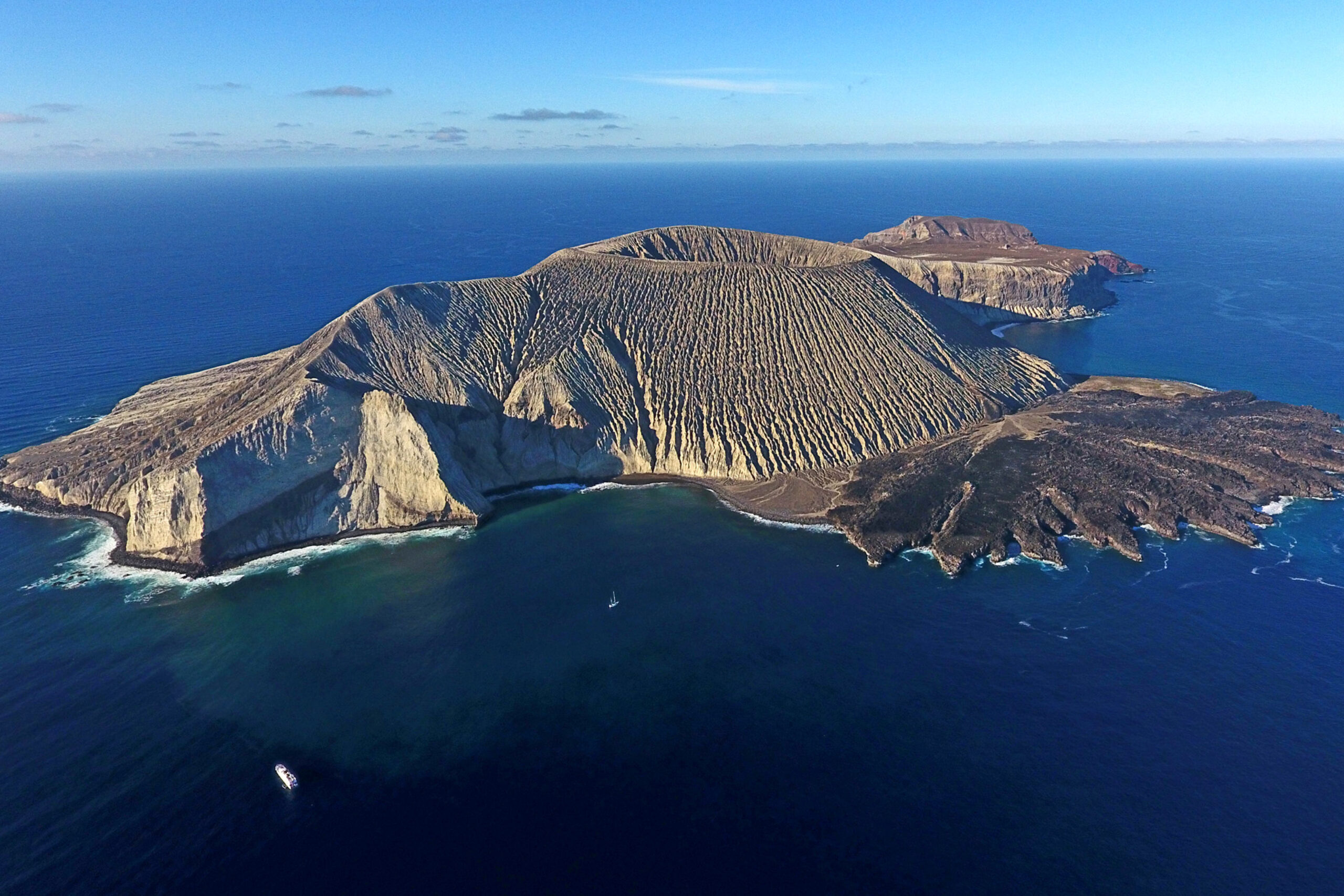
Socorro, Revillagigedo Islands
Socorro, Revillagigedo Islands
Dive with the largest pelagic marine species of the planet
Go to Socorro if you wanna dive with the large pelagic species of marine life: humpback whales, whale sharks, giant manta rays, dolphins, and different species of sharks. Socorro is a volcanic island that rises abruptly from the sea to 1.050 meters (3.440 feet) in elevation at its summit and is part of the Revillagigedo Archipelago, a Mexican territory lying 600 km (370 mi) off the country’s western coast. The archipelago of Revillagigedo are four wild and remote islands, where the weather is unpredictable: San Benedicto, Socorro, Roca Partida, and Clarion, commonly known together as “Socorro Islands”.
SCUBA DIVING
Socorro lies along the junction where the California and Equatorial current mix generating a complex and productive transition zone rich in marine life with stop overs for wide ranging pelagic species: humpback whales, hammerhead sharks, sharks, dolphins, tuna, manta rays, jackfish, marlins, and wahoo, as renowned world diving destinations as Galapagos and Cocos, but in the case of Socorro easily accessible. It is necessary to remember that Socorro Island is 250 nautical miles from Cabo San Lucas, a port on the southern tip of the Baja California peninsula in Mexico.
The Mexican government has implemented restrictions on dive tourism to limit the number of liveaboards operating in Socorro, and fishing is now regulated through a marine area zoning system. Socorro initially gained worldwide fame for the unbelievably close and intimate giant manta ray encounters. Today, Socorro Islands are also known for its abundant school of sharks, and a large population of up to 2,000 humpback whales visit the islands. Killer whales (orcas) and pilot whales can occasionally be seen in Socorro waters. Also, at least 10 endemic fish species, and a few endemic species of birds and lizards.

Socorro initially gained worldwide fame for the unbelievably close and intimate giant manta rays encounters
DIVE SITES
Roca Partida
Roca Partida ranks as one of the best dive sites in the world for big animal encounters. An isolated pinnacle attracts a remarkable marine life: Galapagos sharks, large schools of jacks and bonito, getting hunted by dolphins, tunas, humpback whales, and oceanic giant rays, as well as whale sharks in season.
The Boiler
The Boiler is a dive site at San Benedicto Island, known for its abundant marine life, particularly oceanic mantas and sharks. It’s a submerged sea mount that rises close to the surface, giving the water the appearance of boiling due to breaking waves and swell.
The Canyon
The Canyon is a popular for its deep-water diving and abundant marine life, particularly sharks. Located south of the island, it’s a massive underwater canyon with a ridge of volcanic mountains. Divers can expect to encounter silky sharks, Galapagos sharks, schools of hammerheads, and mantas.
Cabo Pearce
Cabo Pearce is a dive site with abundant marine life and strong currents. Divers can expect to see manta rays, dolphins, hammerheads, silky sharks, and humpback whales.

From February to April Socorro hosts one of the event most stunning of the nature: the humpback whales migration
Punta Tosca
Punta Tosca is a popular dive site with vibrant underwater landscape and diverse marine life. It features a series of lava fingers that create a unique topography, with ridges slowly descending into the ocean. Divers can expect to see manta rays, dolphins, hammerhead sharks, tuna, jacks, reef sharks, and sometimes humpback whales and whale sharks during specific seasons. Punta Tosca also supports a colorful marine life, making it a good spot for macro photography.
The Aquarium
The Aquarium is a vibrant reef fish. Divers can expect to see colorful reef inhabitants, schools of fish, and potentially encounter giant manta rays, whale sharks, and other large pelagic like dolphins and hammerhead sharks. The area is described as an aquarium-like marine haven with excellent visibility on some days.
Red Rocks
Red Rocks is a vibrant underwater location of red-tinged volcanic rock formations, offering divers numerous nooks, crannies, and swim-throughs to explore. The marine life of this dive site includes moray eel, sea turtle, and the opportunity to encounter friendly manta rays and other large pelagic animals.
Roca Oneal
Roca O’Neal, known as “Hammerhead Central”, is a popular dive site of strong currents and abundant hammerhead shark activity, making it a prime destination for deep-water diving and shark enthusiasts.
DIVING SEASON
The primary diving season in the Socorro Islands is from November to June, when liveaboard itineraries are most frequent, as the weather is generally calmer and the water temperatures are at their most favorable. The best diving season in Socorro depends on what you want to see. From November to June, the water temperature varies from 27 to 21 degrees, while from November to December it is more stable from 27 to 26 degrees. During this period, manta rays, 10 types of sharks, and bottlenose dolphins gather. From January to April, the water is colder, with minimum peaks around 21 degrees. During this period, the humpback whales arrive. Diving encounters with these marine giants are becoming more and more numerous. November/December and May/June are the whale shark seasons in the Socorro Islands.

November/December and May/June are the whale sharks seasons in Socorro Islands
HOW TO GET THERE
The liveaboard diving cruises to Socorro depart from Cabo San Lucas and San Jose del Cabo, both in Los Cabos, Mexico, on the peninsula of Baja California. The closest international airport is Los Cabos International Airport, which has flights arriving from the United States, Canada, and other Mexican Cities. Of course, we will organize your arrival, transfers, and eventual stay pre-cruise night.
The crossing from Cabo San Lucas to Socorro takes 24 hours. Seas can be rough and cause discomfort for those suffering from seasickness. The dive cruises last between 8 and 10 nights.
LIVEABOARD & PRIVATE CRUISES
The Socorro Islands are only accessible by sea, and since they are largely uninhabited, the only way to visit and dive them is on a liveaboard. Which liveaboards have established the Socorro Islands as a premier diving destination? Here you will find a selection of the most experienced liveaboard operating in the Revillagigedo Archipelago:
Solmar V
The Solmar V has operated in Socorro since 1994, providing 8, 9, and 10-night itineraries. This seasoned liveaboard offers great value for diving cruises to encounter the largest pelagic species of marine life. Solmar V can accommodate 22 divers in 12 cabins: two singles, four standard twins, and six superior twins. Each cabin has a private bathroom and air conditioning. The superior cabins in the center of the boat are slightly more spacious than the others. There is also a comfortable restaurant, where guests can relax during their free time.

Nautilus Belle Amie
The Belle Amie is the newest and largest of the Nautilus liveaboards. She feels like a 5-star floating boutique hotel, boasting a spacious salon and dive deck. This luxury liveaboard is a 41-meter yacht designed for diving and navigating on the high seas. Stable and safe, it can accommodate 30 divers in 17 cabins of different conformations, from standard to premium suites. The common areas include a large sundeck and a comfortable lounge with a TV screen and a bar. The dives are carried out by three rubber tenders.

Rocio del Mar
Rocio del Mar offers 9-night cruises to Socorro and is popular for its diverse diving experiences in Mexico, including the Sea of Cortez and Baja California. It is a 27-meter liveaboard with comfortable accommodations, lots of space for diving gear, expert dive staff, and excellent food. Rocio del Mar has 10 cabins divided on two decks and accommodates up to 20 divers. All cabins have private bathrooms and air conditioning. The restaurant lounge is in the lower front part to minimize rolling.





















